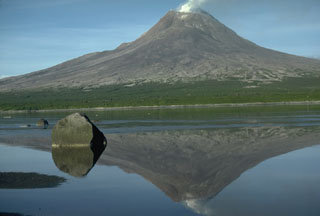Report on Augustine (United States) — February 1986
Scientific Event Alert Network Bulletin, vol. 11, no. 2 (February 1986)
Managing Editor: Lindsay McClelland.
Augustine (United States) Increased seismicity; minor ash emission
Please cite this report as:
Global Volcanism Program, 1986. Report on Augustine (United States) (McClelland, L., ed.). Scientific Event Alert Network Bulletin, 11:2. Smithsonian Institution. https://doi.org/10.5479/si.GVP.SEAN198602-313010
Augustine
United States
59.3626°N, 153.435°W; summit elev. 1218 m
All times are local (unless otherwise noted)
Juergen Kienle reports that seismicity at Augustine began to increase last summer for the first time since 1976, when the volcano last erupted. Between 12 July and 7 August, approximately 300 shallow microearthquakes were recorded each day on Augustine's network of four seismic stations. From then until late February, recorded earthquakes averaged 12/day, with occasional short bursts of seismicity. A small swarm took place during September with 100 events/day over a 2-3-day period. An intense peak occurred on 22 February between 0700 and 0800, when 70 microearthquakes were recorded on the seismometer less than 1 km from the dome, 2 hours before USGS scientists flew over the volcano and reported active degassing (see below). Since the end of February, seismicity has intensified, with concentrated swarms (3-4 events/hour lasting 1-2 hours) occurring approximately twice a day. These microearthquakes were all shallow and indicate fracturing and degassing of the dome.
The following is a report from M.E. Yount. "On 17 February, James Riehle saw what he believed to be an explosion plume over Augustine Volcano, while on Wolverine Peak more than 300 km from Augustine. The plume rose to an estimated altitude of more than 3 km. It was dispersed by winds within ~0.5 hour, with the lower portion of the plume drifting W or NW and the upper portion drifting E or SE. Seismic recorders at the USGS office in Anchorage, which monitor some of the University of Alaska Geophysical Institute seismometers, had shown an increase in small events near Augustine, beginning 13 February. On 20 and 21 February, the USGS began receiving reports from observers in Homer (110 km NE of Augustine) and from pilots flying near the volcano that it was vigorously steaming.
"On 22 February, USGS personnel flew over the volcano and confirmed that it was actively degassing from the moat around the summit dome. The main fumarolic vent was in the moat E of the dome. During the observations (between 1000 and 1018), fumarolic activity was continuous and steady. The plume was whitish, with a few grayish wisps. The SE and W sectors of the snow-covered cone were lightly dusted with ash, believed to be comminuted portions of the 1976 dome. No sign of avalanches or falling blocks from the dome were observed. During a 28 February overflight, USGS personnel noted an increase in the amount and area of fumarolic activity compared to 22 February. Augustine may be following its traditional pattern of slowly forcing the summit dome up followed by dome destruction and pyroclastic flow activity."
On 14 March, images from the NOAA-9 polar orbiting satellite showed a plume extending ~50 km S from Augustine at 1413 and 1555. No plume had been visible on 13 March, and clouds obscured the area 15-17 March. USGS scientists also flew over the volcano on 14 March, noting that the plume rose ~1,000 m above the summit and looked similar to the plume seen during their overflight on 28 February.
Geological Summary. Augustine volcano, rising above Kamishak Bay in the southern Cook Inlet about 290 km SW of Anchorage, is the most active volcano of the eastern Aleutian arc. It consists of a complex of overlapping summit lava domes surrounded by an apron of volcaniclastic debris that descends to the sea on all sides. Few lava flows are exposed; the flanks consist mainly of debris-avalanche and pyroclastic-flow deposits formed by repeated collapse and regrowth of the summit. The latest episode of edifice collapse occurred during Augustine's large 1883 eruption; subsequent dome growth has restored the edifice to a height comparable to that prior to 1883. The oldest dated volcanic rocks on Augustine are more than 40,000 years old. At least 11 large debris avalanches have reached the sea during the past 1,800-2,000 years, and five major pumiceous tephras have been erupted during this interval. Recorded eruptions have typically consisted of explosive activity with emplacement of pumiceous pyroclastic-flow deposits followed by lava dome extrusion with associated block-and-ash flows.
Information Contacts: Juergen Kienle, Geophysical Institute, University of Alaska, Fairbanks; M.E. Yount, T. Miller, and James Riehle, USGS Anchorage; M. Matson, NOAA/NESDIS.

